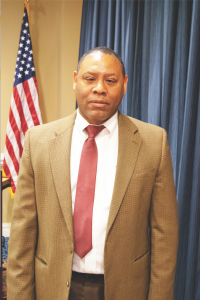History department hosts symposium about early NC slavery

Dr. Arwin Smallwood
is a professor at NC A&T. Photo by Breanne Valentine
By Nicole Prince
News Editor
The High Point University History Department presented a symposium called Slavery and Its legacy in North Carolina during an all-day event on Oct. 5 in Webb Conference Center. Featured guests lectured and answered questions about their research.
Dr. Arwin Smallwood of North Carolina Agricultural and Technical State University in Greensboro, Dr. Adrienne Israel from Guilford College, Dr. Virginia Summey from University of North Carolina-Greensboro and Dr. Flora J. Hatley Wadelington each discussed various aspects of how race relations were impacted by slavery and Jim Crow laws.
Smallwood, who writes widely on the subjects of African Americans, Native Americans, Europeans and Colonial North Carolina, began his lecture, titled “Red, Black and White: The Origins and Growth of Slavery in Colonial North Carolina,” by expressing the importance of the development of the state, particularly through the evolution of Colonial American slavery, beginning with the Spanish.
He presented 16th-century drawings by Bartolomé de las Casas, who traveled with conquistadors, to display the havoc wreaked on North Carolina by the Spanish. During this time, the Spanish campaigned against the Indians, murdering families and plundering villages.
He discussed race mixing during the period, as it strongly related to the spread of disease, the arrival of the English, the exploitation and sacrifice of Native Americans, Drake’s 600 and the “Lost Colony” of Roanoke.
“In 1586, a year before the whites were introduced in 1587, and 33 years before Africans were brought to Jamestown, Sir Francis Drake brought over 600 West African Moors and Maroons,” said Smallwood.
Maroons, he explained, were runaway slaves that lived in the swamps of the Caribbean and North America. Drake captured them and offered them freedom in exchange for their help with his plundering. Upon Drake’s arrival on Roanoke island, he released them and left with all acquired loot. They were the first African people in the colony of “Virginia,” which encompassed modern NC, according to archived maps from the period.
Drake’s abandonment prompted Maroons to begin mixing with local natives, populating the massive swampland throughout Eastern North Carolina. Smallwood stressed the importance of such background information because it indicates the first Africans in the state were not slaves.
“They were soldiers,” he said. “That they were slaves is the first myth I want to dispel. They blended with the Indian populations of Eastern North Carolina to create mixed race Indians that still exist in NC today. We forget how these early people are blended not as slave people but as free people, developing a different type of people. We see a merge of those cultures.”
In 1619, a second phase happened, during which over 20 blacks were brought to Virginia to live, work and become indentured servants.
“I do not particularly agree with my colleagues around the country who talk about these blacks as enslaved people because when their servitude was up, they became free,” said Smallwood. “You can look in the Virginia record and see that these free blacks owned land, plantations and white, black and Indian indentured servants. It was not until Virginia changed the law to decide that people of color who had black blood were negroes and, therefore, would be slaves forever, that we began to see changes in Virginian society. When Virginia changed the law to legalize slavery and strip the freedoms from the free black population, they left Virginia and moved to the frontier.”
“We see large numbers of mixed race people moving down from Virginia and settling particularly in Eastern North Carolina to get away from these new laws that are being passed in Virginia,” said Smallwood.
He spoke extensively about the deep roots of independence and free blacks, either as Maroons, runaway slaves or just people of color, in Eastern North Carolina before the expansion of slavery and before the development and growth of North Carolina.
“Keep in mind that you have three unique cultures, three unique African American communities that are evolving and developing at the same time,” said Smallwood. “There are Maroon communities, which are autonomous and independent with their own form of government and leadership. There are slave communities in which the slaves are on plantations being exploited and taken advantage of by their white slave owners. There are free black communities who are trading with, living with and negotiating with the Indians on the frontier.”
North Carolina legalized slavery in 1715. This date is significant because the Tuscarora War broke out in 1711 and ended in 1713. In 1715, there was a call for the complete extermination of all Tuscarora people and the slaughter and enslavement of children, who were then forced to be bred with African men throughout the colony that eventually became the state of North Carolina.
The Tuscarora people were trading people and occupied some of the most fertile farmland. When the Tuscarora War ended, not only did the North Carolinians receive hundreds of slaves, but it opened up some of the most fertile farmland in NC, now famously known for agriculture and the growing of tobacco.
After Smallwood’s discussion about the evolution of slavery and culture, Israel, Summey and Wadelington presented their research, followed by a plenary session and concluding remarks.